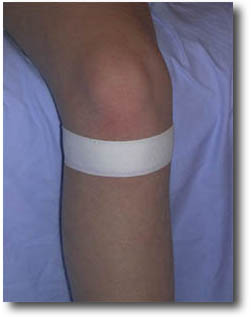Training ladder for:
MENISCUS LESION
(LAESIO TRAUMATICA MENISCI)
STEP 4 |
|
|||||||||||||||||||||||||||||||||||||||||||||||||

Training ladder for:
MENISCUS LESION
(LAESIO TRAUMATICA MENISCI)
STEP 4 |
|
|||||||||||||||||||||||||||||||||||||||||||||||||
Training ladder for:
MENISCUS LESION
(LAESIO TRAUMATICA MENISCI)
STEP 3 |
|
|||||||||||||||||||||||||||||||||||||||||||||||||
Training ladder for:
MENISCUS LESION
(LAESIO TRAUMATICA MENISCI)
STEP 2 |
|
|||||||||||||||||||||||||||||||||||||||||||||||||||||
Training ladder for:
MENISCUS LESION
(LAESIO TRAUMATICA MENISCI)
STEP 1 |
|
||||||||||||||||||||||||||||||||||||||||||||||||||||||||||||
|
Placement of intra-articular injections verified by ultrasonography and injected air as contrast medium. |
Training ladder for:
JUMPER’S KNEE
(JUMPER´S KNEE)
STEP 4 |
Unlimited: Cycling. Swimming. Running on a soft surface.
|
|||||||||||||||||||||||||||||||||||||||||||||||||||||||||||||
|
Stretching is carried out in the following way: stretch the muscle group for 3-5 seconds. Relax for 3-5 seconds. The muscle group should subsequently be stretched for 20 seconds. The muscle is allowed to be tender, but must not hurt. Relax for 20 seconds, after which the procedure can be repeated. The time consumed for stretching, coordination and strength training can be altered depending on the training opportunities available and individual requirements. |
Training ladder for:
JUMPER’S KNEE
(JUMPER´S KNEE)
STEP 3 |
Unlimited: Cycling with weak load. Swimming. Running with increasing distance on a soft surface.
|
|||||||||||||||||||||||||||||||||||||||||||||||||||||||||||||
|
Stretching is carried out in the following way: stretch the muscle group for 3-5 seconds. Relax for 3-5 seconds. The muscle group should subsequently be stretched for 20 seconds. The muscle is allowed to be tender, but must not hurt. Relax for 20 seconds, after which the procedure can be repeated. The time consumed for stretching, coordination and strength training can be altered depending on the training opportunities available and individual requirements. |
Training ladder for:
JUMPER’S KNEE
(JUMPER´S KNEE)
STEP 2 |
Unlimited: Cycling with weak load. Swimming. Light running on a soft surface.
|
||||||||||||||||||||||||||||||||||||||||||||||||||||||||||
|
Stretching is carried out in the following way: stretch the muscle group for 3-5 seconds. Relax for 3-5 seconds. The muscle group should subsequently be stretched for 20 seconds. The muscle is allowed to be tender, but must not hurt. Relax for 20 seconds, after which the procedure can be repeated. The time consumed for stretching, coordination and strength training can be altered depending on the training opportunities available and individual requirements. |
Training ladder for:
JUMPER’S KNEE
(JUMPER´S KNEE)
STEP 1 |
| The indications of time after stretching, coordination training and strength training show the division of time for the respective type of training when training for a period of one hour. The time indications are therefore not a definition of the daily training needs, as the daily training is determined on an individual basis.
|
||||||||||||||||||||||||||||||||||||||||||||||||||||
|
Stretching is carried out in the following way: stretch the muscle group for 3-5 seconds. Relax for 3-5 seconds. The muscle group should subsequently be stretched for 20 seconds. The muscle is allowed to be tender, but must not hurt. Relax for 20 seconds, after which the procedure can be repeated. The time consumed for stretching, coordination and strength training can be altered depending on the training opportunities available and individual requirements. |
Objective: The load on the tendon fastening can be adjusted with use of tape, so that the maximum load is moved to another part of the tendon fastening allowing the injured part to be relieved. |
|||
 |
|||
| Application: One or two tape “anchors” are applied around the lower leg just below the lower edge of the kneecap. The tape must not be fixed so tightly so as to cause any discomfort from the lower leg or foot (cold sensation, sleeping sensation). |